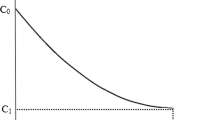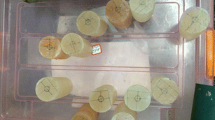Abstract
The dissolution process of the rock salt is actually a complicated process in fluid dynamics and chemical kinetics; therefore, the mathematical model for the solute-fluid flow during the cavern building may be established to research the change rule of the form of the cavern boundary based on the kinetic analysis of the convection–diffusion process, with integration of the basic theories of fluid mechanics and the principles of chemical kinetics. In order to research the dissolution mechanism of the rock salt under the condition of dynamic water, the method of numerical simulation has been employed to simulate and study the factors with effect on the fluid transport mechanism in solution mining cavern of the rock salt, and its dissolution in dynamic water has been simulated and researched. The result shows that the model established in this paper may well describe the dissolution process of rock salt under the condition of dynamic water, providing basic analyzing means for the research on the rock salt dissolution in dynamic water.














Similar content being viewed by others
References
Deng QH, Tang GF (1999) New method on determining boundary conditions of pressure correction equation in SIMPLE algorithm. J Hunan Univ (natural science edition) 26(6):65–70 (in Chinese)
Essink GHPO (2001) Salt water intrusion in a three-dimensional groundwater system in the Netherlands: a numerical study. Transp Porous Med 43:137–158
Fairchild IJ, Killawee JA, Hubbard B, Dreybrodt W (1999) Interactions of calcareous suspended sediment with glacial meltwater: a file test of dissolution behaviour. Chem Geol 155:243–263
Finneran DW, Morse JW (2009) Calcite dissolution kinetics in saline waters. Chem Geol 268:137–146
Gechter D, Huggerberger P, Ackerer P, Waber HN (2008) Genesis and shape of natural solution cavities within salt deposits. Water Resour Res 44:1–18
Gledhill DK, Morse JW (2004) Dissolution kinetics of calcite in NaCl-CaCl2-MgCl2 brines at 25°C and 1 bar PCO2. Aquat Geochem 10:171–190
Kaufmann G, Braun J (1999) Karst aquifer evolution in fractured rocks. Water Resour Res 35:3223–3238
Liang WG, Zhao YS, Xu SG, Dusseat MB (2008) Dissolution and seepage coupling effect on transport and mechanical properties of glauberite rock salt. Transp Porous Med 74(2):185–189
Liu CL, Xu LJ, Xian XF (2002) Fractal-like kinetic characteristics of rock salt dissolution in water. Colloid Surf A 201(1–3):231–235
Liu XR, Yang X, Zhong ZL, Liang NH, Wang JB, Huang M (2015) Research on dynamic dissolving model and experiment for rock salt under different flow conditions. Adv Mater Sci Eng 2015:1–10. doi:10.1155/2015/959726
Luo J, Dierch HJG, Monninkhoff LMM (2012) 3D Modeling of saline groundwater flow and transport in a flooded salt mine is Stassfurt, Germany. Water Environ J 31:104–111. doi:10.1007/s10230-012-0181-9
Rezaei M, Sanz E, Reeisi E, Ayora C, Vazquez-Sune E (2005) Reactive transport modeling of calcite dissolution in the fresh-salt water mixing zone. J Hydrol 311:282–298
Truesdale VW, Sebu C (2013) A new analytic integration of the rate equation for batch dissolution of salts in the presence of common ion. Aquat Geochem 19:39–56
Weisbrod N, Alon-Mordish C, Konen E, Yechieli Y (2012) Dynamic dissolution of halite rock during flow of diluted saline solutions. Geophys Res Lett 39:1–7
Zechner E, Konz M, Younes A, Huggenberger P (2011) Effects of tectonic structures, salt solution mining, and density-driven groundwater hydraulics on evaporite dissolution (Switzerland). Hydrogeol J 19:1323–1344
Zhao ZC (2003) Theory of fluid transportation and configuration development in solution mining cavern for underground gas storage. Ph.D. Dissertation, Percolation mechanics research institute of Chinese academy of sciences (in Chinese)
Zidane A, Zechner E, Huggenberger P, Younes A (2014a) Simulation of rock salt dissolution and its impact on land subsidence. Hydrol Earth Syst Sc 18:2177–2189
Zidane A, Zechner E, Huggenberger P, Younes A (2014b) On the effects of subsurface parameters on evaporite dissolution (Switzerland). J Contam Hydrol 160:42–52
Acknowledgements
This study is supported by the Scientific Research Foundation of Fujian University of Technology (Grant No. GY-Z160051), the Fujian Provincial Natural Science Foundation Projects (Grant No. 2017J05070); we gratefully acknowledge these supports.
Author information
Authors and Affiliations
Corresponding author
Additional information
This article is part of a Topical Collection in Environmental Earth Sciences on ‘Subsurface Energy Storage’, guest edited by Sebastian Bauer, Andreas Dahmke, and Olaf Kolditz.
Rights and permissions
About this article
Cite this article
Yang, X., Liu, X. Numerical simulation of rock salt dissolution in dynamic water. Environ Earth Sci 76, 427 (2017). https://doi.org/10.1007/s12665-017-6768-5
Received:
Accepted:
Published:
DOI: https://doi.org/10.1007/s12665-017-6768-5




